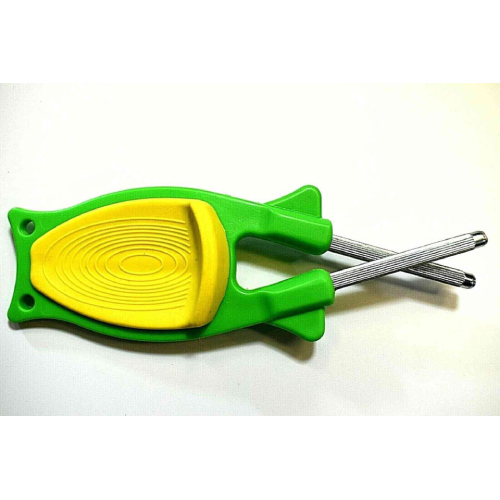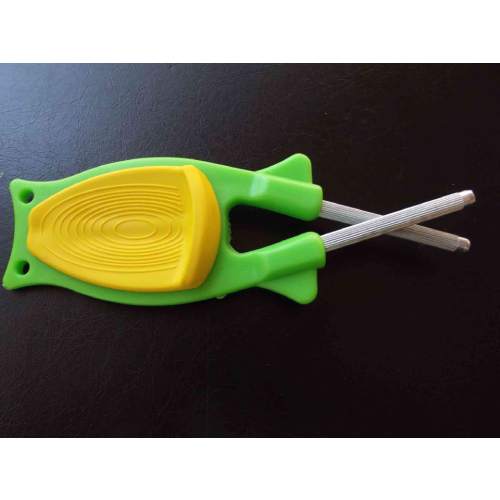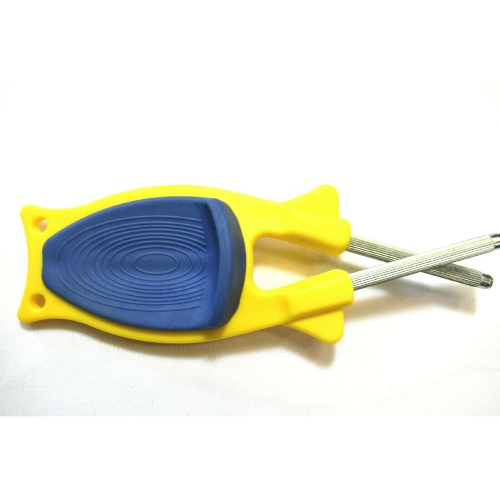Description
Block’s Green knife sharpener for sale online is a new patent Made in America handheld knife sharpener that relines and hones blade.
New patent Green knife sharpener.
Block knife sharpener for sale online. Block’s sharpeners are quick and simple to use handheld knife sharpener that reline and hone your blades.
The Block family are the original manufacturers of these style knife sharpeners est.1969. (Aka; Butcher Block sharpener & later years Easy sharpener.) Don’t be fooled by look Alike’s, they do not work the same. Block sharpeners are a patent sharpener made to reline and hone blades back to their original cutting edges. You will find our sharpeners can take knives much sharper than brand new. Here are some knife sharpening videos to show you different techniques I use to sharpen different types of blades and cutting edges that you may find around your home. With Blocks patent flex design, this enables the honing rods to adjust to many different types of cutting edges.
Knife Edge Styles
- V-edge the V-edge is the most common style for kitchen knives. …
- Double bevel or Compound Edge A double beveled edge, also known as a compound edge, is essentially a double-layered V-edge. …
- Chisel edge Chisel edges are most commonly found on Japanese sushi knives like Santokus and Nakiris. …
- Convex edge …
- Hollow edge …
- Serrated edge …
- Granton edge …
Knife Edge Styles
Every knife blade is ground uniquely to form a sharpened edge. Each side of the blade that has honed an edge is referred to as a bevel. If you look closely at the blade of your kitchen knives, you should notice a part at the very edge that angles more steeply–this is the bevel.
Kitchen knives are easily one of the most commonly used tools on the planet. They are simple yet used for a variety of culinary tasks daily. But the very cutting edge that we rely on — and the source of the knife’s power–is nearly invisible to the unaided eye, a reason why we seem to take these trusty instruments for granted.
The majority of kitchen knives are flat ground, meaning the blade begins to taper from the spine to the edge. However, knife edges come in a variety of styles and differences in the way the blade is ground to make it sharp. If you look closely at the blade of your kitchen knives, you should notice a part at the very edge that angles more steeply–this is the primary bevel. Most of the time people refer to the Edge Angle—see the image below. Typically, this is about 15º to 25º for kitchen knives.
Cutting edges that you can sharpen with a Block’s Green knife sharpener.
 (1) Block knife sharpener – YouTube. 
(1) Block knife sharpener – YouTube. 
The V-edge is the most common style for kitchen knives. Like the letter V, these blades slant directly from the spine to the edge at a symmetric angle.
V-edges are the preferred design for most kitchen knife makers as they are easy to sharpen and hold their edge longer, though durability is sacrificed in favor of a fine edge.
Double bevel or Compound Edge
A double beveled edge, also known as a compound edge, is essentially a double-layered V-edge. Picture a large V with a smaller V on top of it. This is my favorite overall. It’s sharp and durable.
The secondary bevel, also known as a relief angle, serves to make the metal behind the edge thinner. In principle, a thinner-edged blade has a greater cutting ability given its lack of friction—but it is also more likely to sustain damage.
The idea behind a double bevel is to make the edge stronger and more resistant to rolling and cracking with the support of the secondary bevel.
A couple of Chef’s Choice knife sharpeners work this way—The M1520 and the M120 for example.
Chisel edge
Chisel edges are most commonly found on Japanese sushi knives like Santokus and Nakiris.
These blades are only ground on one side to form a single primary bevel, while the other side is left straight and flat. For this reason, chisel edge knives can be found in both left-handed and right-handed varieties.
The edge is usually sharpened between 20º and 25º, which comprises the total angle of the edge (the flat side hasAdd product gallery images an angle of 0). Such an acute angle makes chisel edges exceptionally thin and sharp compared to most American and European knives.
This design makes chisel edge knives the preferred style for cutting delicate raw fish in sushi restaurants.
Convex edge
Convex edge blades feature two outward arcs that slope in and intersect at the edge. The resulting look of the edge resembles the slope of an airplane wing.
The curved design puts more steel behind the edge, making it stronger and sharper than V-edged blades.
Since the creation of a convex edge is a bit more sophisticated than others, they can be more difficult to sharpen effectively with home sharpeners. Because of this, convex edges often lose their shape and are eventually shaved down to V-edges.
Hollow edge
Hollow edge blades, also known as concave edges, curve inward–the opposite direction of convex edges.
These blades can get very sharp, are usually reserved for hunting and survival knives.
Some bargain-brand butcher knives may employ a hollow edge, but most quality kitchen sets will feature a stronger V-edge.
Serrated edge- sharpens any style serrated edge.
Like chisel edges, serrated-edged blades are ground on only one side. The distinguishing features of serrated edges are the mini-arches, or teeth, that serve to protect the actual cutting surface and keep the edge sharp. block sharpener will sharpen any serrated edge knife.
See how we do it with our green knife sharpener videos.
You will find with our unique flex design in our sharpener handle you can sharpen many different types of cutting edges. Like all V -shaped edges form 16 degrees threw 28 degrees, convent edges, serrated edges, scissor edges and odd shaped blades like found on snake shaped daggers or hawkbill work knife.
















Steve Cantina –
Well made sharpener. works great Great deal thank you Paul and Billie jo
Jacob Lindemann –
Great product and takes the skill work out of honing. I use a great jig sharpener to bring the edge back out on all of my knives from kitchen to pocket, before purchasing that system I saw this product pop up on YouTube and while I think the home-made ads about this tool are misleading it does a great job for what I use it for now.
Without any prior knowledge on sharpening methods I felt that the message on this product was that this tool is all you need to get your knives sharp again; this product does NOT repair damaged and chipped blades and simply running a worked edge through this system will not repair an edge and get a worked knife sharp again.
Once I did more research on how to repair a damaged edge and maintain a great cutting edge in between sharpening sessions this is a go to tool for my kitchen use.
Utilizing this product as a guided honing tool is awesome and I use it to hone my kitchen knives every single time before use and it’s pulled out every time we cook.
Joe A –
The product works AWESOME better than advertised. Compact enough to put in my knife sheath & very well made. I loved it so much i bought 4 & on top of that Mr Billie Jo Block was SO VERY HELPFUL great customer service. Highly recommend this product & company! I sent one to my Son who is in the Marines in NC he loves it too. Thank You Billie Jo Block for a great product.
Oldman Jones –
If you can’t put a Razors edge on your knife with this Block Sharpener, than you shouldn’t carry a knife.. Within 10 mins of opening the package of mine, I was dry shaving the hair off my arms with ALL my knives, from the cheap give away knives to my G. Hibbens, pocket knives to 12′ inch Bowies. Rockwell 59 knives… I HIGHLY RECOMMED THIS LIL WONDER…. Also it does not take much practice, just a Good eye and Good sense of Touch… if need be, watch you tube videos… simple